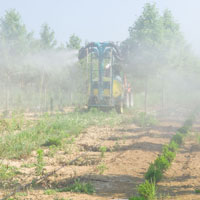Human Exposure and Atmospheric Sciences
Chlordane Pesticide Dataset
Published measurements of chlordane enantiomers in the environment

Issue
Chlordane pesticide was used in the United States from the 1940s until 1988, when all approved uses of the pesticide were cancelled. It was used to control termites in homes and other insects on crops. Chlordane pesticide is a complex mixture of chemicals that have a similar chemical structure. Research suggests exposure to chlordane has the potential to cause adverse health effects. Components of chlordane pesticide have been found to be persistent in the environment and have been found in air, water, soil, sediment, plants, and some animals. Read more on chlordane.
The complexity of the chlordane formulation is due in part to the fact that chlordane is a chiral compound or, in other words, a chemical that has different mirror images. To understand this concept, look at your hands. They are a mirror image of each other. Even though they look the same, if you try to stack your hands, your thumbs will be on opposite sides. This is an example of chirality. In the same way, a chiral compound like chlordane has two forms that are mirror images of each other. These molecular forms are known as enantiomers. Enantiomers usually seem and behave the same way; but can degrade differently in the environment and react in unique ways when coming into contact with other chiral compounds. Scientists can look at the rate at which chlordane enantiomers degrade in the environment to estimate potential human exposures and health risks. Research shows that sometimes the less toxic enantiomer degrades faster in the environment therefore increasing the toxicity and risk of the remaining mixture compared to the original product. Sometimes the more toxic enantiomer degrades faster in the environment, decreasing the toxicity and risk compared to the original product.
To better understand the potential exposure risk to chlordane, researchers have developed laboratory methods to measure the amount and toxicity of each chlordane enantiomer. Although there are hundreds of publications providing information and data on chlordane enantiomers, these publications span many years and numerous journals. A centralized tool was needed to allow for easier access to this valuable information.
Action
EPA scientists have developed a Chlordane Pesticide Dataset that compiles chlordane measurements from published literature in one place. The dataset provides researchers with a useful resource that taps into peer reviewed published results, summarizing and organizing the data into a user friendly tool.
Results and Impact
The dataset compiles about 2,400 enantiomer-specific measurements for five pairs of chlordane enantiomers. Data were compiled from research articles published from 1992 through March 2011. The broad data set allowed for a review of the state of the science and a detailed analysis of the data. For organizational purposes, the dataset includes the bibliographical reference and reports results separated into 15 different environmental compartments - including water, soil, and indoor air.
This dataset for chlordane enantiomers is the most complete and updated resource of its kind for researchers. It consolidates information that may be useful for scientists interested in studying trends, estimating exposure and toxicity of mixtures, developing methods, and modeling enantiomers. Scientists have found that small differences in the environment - be it differences in plant tissue, animal species, or soil characteristics - can lead to significant differences in enantiomer mixtures. Understanding these differences can help scientists develop a deeper understanding of the fate and transport of chlordane pesticide. Because this data is compiled and publically available, researchers will not have to search the literature for these values or references. Anyone can use this data set to find reference values, literature citations, compare new results with historical ones, or investigate new hypotheses.
Reference
Ulrich, E. and R. L. Falconer, "Chiral chlordane components in environmental matrices", ACS symposium series "Chiral Pesticides: Stereoselectivity and its Consequences" edited by A. W. Garrison, W. Liu, and J. Gan. pp 11-43; DOI: 10.1021/bk-2011-1085.ch002.
Technical Contact
Elin M. Ulrich, Ph.D
